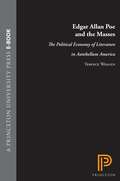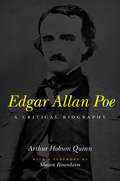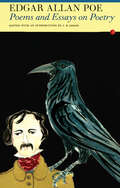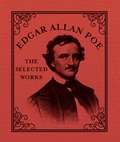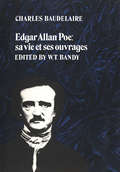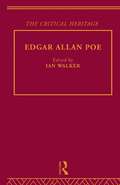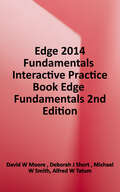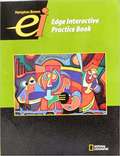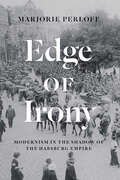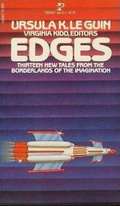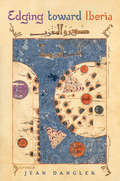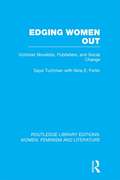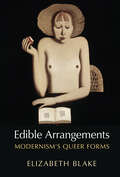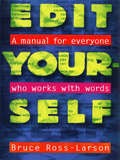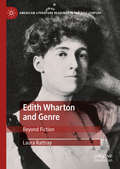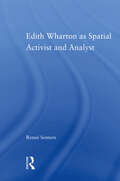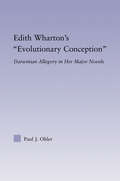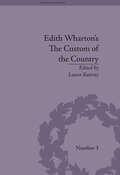- Table View
- List View
Edgar Allan Poe and the Masses: The Political Economy of Literature in Antebellum America
by Terence WhalenEdgar Allan Poe has long been viewed as an artist who was hopelessly out of step with his time. But as Terence Whalen shows, America's most celebrated romantic outcast was in many ways the nation's most representative commercial writer. Whalen explores the antebellum literary environment in which Poe worked, an environment marked by economic conflict, political strife, and widespread foreboding over the rise of a mass audience. The book shows that the publishing industry, far from being a passive backdrop to writing, threatened to dominate all aspects of literary creation. Faced with financial hardship, Poe desperately sought to escape what he called "the magazine prison-house" and "the horrid laws of political economy." By placing Poe firmly in economic context, Whalen unfolds a new account of the relationship between literature and capitalism in an age of momentous social change.The book combines pathbreaking historical research with innovative literary theory. It includes the first fully-documented account of Poe's response to American slavery and the first exposé of his plot to falsify circulation figures. Whalen also provides a new explanation of Poe's ambivalence toward nationalism and exploration, a detailed inquiry into the conflict between cryptography and common knowledge, and a general theory of Poe's experiments with new literary forms such as the detective story. Finally, Whalen shows how these experiments are directly linked to the dawn of the information age. This book redefines Poe's place in American literature and casts new light on the emergence of a national culture before the Civil War.
Edgar Allan Poe in Context
by Kevin J. HayesEdgar Allan Poe mastered a variety of literary forms over the course of his brief and turbulent career. As a storyteller, Poe defied convention by creating Gothic tales of mystery, horror, and suspense that remain widely popular today. This collection demonstrates how Poe's experience of early nineteenth-century American life fueled his iconoclasm and shaped his literary legacy. Rather than provide critical explications of his writings, each essay explores one aspect of Poe's immediate environment, using pertinent writings - verse, fiction, reviews, and essays - to suit. Examining his geographical, social, and literary contexts, as well as those created by the publishing industry and advances in science and technology, the essays paint an unprecedented portrait of Poe's life and times. Written for a wide audience, the collection will offer scholars and students of American literature, historians, and general readers new insight into Poe's rich and complex work.
Edgar Allan Poe: A Critical Biography
by Arthur Hobson QuinnNow in paperback—the classic, monumental biography of Poe by Arthur Hobson Quinn.Renowned as the creator of the detective story and a master of horror, the author of "The Red Mask of Death," "The Black Cat," and "The Murders of the Rue Morgue," Edgar Allan Poe seems to have derived his success from suffering and to have suffered from his success. "The Raven" and "The Tell-Tale Heart" have been read as signs of his personal obsessions, and "The Fall of the House of Usher" and "The Descent into the Maelstrom" as symptoms of his own mental collapse. Biographers have seldom resisted the opportunities to confuse the pathologies in the stories with the events in Poe's life. Against this tide of fancy, guesses, and amateur psychologizing, Arthur Hobson Quinn's biography devotes itself meticulously to facts. Based on exhaustive research in the Poe family archive, Quinn extracts the life from the legend, and describes how they both were distorted by prior biographies.
Edgar Allan Poe: Selected Poems and Essays
by Edgar Allan PoeHis reputation has never settled, seeing as many reversals after his death as during his life. Though read and enjoyed ny many, fewer admire him openly. This volume includes all of his poetry and his most important essays.
Edgar Allan Poe: The Selected Works (RP Minis)
by Edgar Allan PoeThis entertaining anthology includes four of Edgar Allan Poe’s most popular tales of terror (The Masque of the Red Death, The Tell-Tale Heart, The Cask of Amontillado, and The Black Cat) and a selection of his haunting poetry reprinted in full, along with an introduction and biography on the Master of the Macabre.
Edgar Allan Poe: sa vie et ses ouvrages
by Charles Baudelaire W. T. BandyThe earliest foreign study of the life and works of Edgar Allan Poe, the text presented in this volume is something of a landmark in the history of comparative literature. Baudelaire's first and longest essay on Poe was published in the Revue de Paris is 1852; it was revised and abridged for use as the preface of the first volume of his translation of Poe's tales, Histoires extraordinaires. This study was significant especially in the area of Franco-American literary relations because it was the basis of not only the French attitude toward Poe, but of his reputation throughout Europe--one might almost say, throughout the world. The essay on Poe has never been the subject of a separate publication. This edition reveals for the first time the sources of information used by Baudelaire. It shows that a considerable part of the study was translated literally from articles by John M. Daniel and John R. Thompson in the Southern Literary Messenger (1849-50). Previous editions vary widely in excellence because almost all suffered from the mistaken belief that Baudelaire was acquainted with the American edition of Poe's works when he wrote the 1852 essay and that it was largely based on Rufus Griswold's Memoir contained in that edition. This led to the commentary and notes that were unconsciously misleading and in many cases false.The introduction to this edition presents a complete and accurate account of the genesis of Baudelaire's essay, with supporting documents showing his indebtedness to American, French, and British sources. It enables the reader to distinguish clearly between what Baudelaire himself knew or thought about Poe and what he borrowed from other writers.
Edgar Allen Poe: The Critical Heritage (Critical Heritage Ser.)
by Ian WalkerThis set comprises 40 volumes covering nineteenth and twentieth century European and American authors. These volumes will be available as a complete set, mini boxed sets (by theme) or as individual volumes. This second set compliments the first 68 volume set of Critical Heritage published by Routledge in October 1995.
Edge 2014 B: Grammar And Writing Practice Book (Edge Series)
by Hampton-BrownMultiple practice and review pages for each grammar skill, contextualized application of grammar skills through writing.
Edge 2014 Fundamentals: Interactive Practice Book (Edge Fundamentals)
by Michael W. Smith Deborah J. Short David W. Moore Alfred W. TatumInteractive reading selections, ample practice with vocabulary, reading and literary analysis skills.
Edge Level B Interactive (Practice Book)
by National Geographic LearningInteractive reading selections. Ample practice with vocabulary, reading, and literary analysis skills.
Edge Level C Interactive: Practice Book (Hampton-Brown Edge: Reading, Writing, & Language ©2009)
by National Geographic Learning National Geographic LearningAmple practice with vocabulary, reading, and literary analysis skills.
Edge of Irony: Modernism in the Shadow of the Habsburg Empire
by Marjorie PerloffAmong the brilliant writers and thinkers who emerged from the multicultural and multilingual world of the Austro-Hungarian Empire were Joseph Roth, Robert Musil, and Ludwig Wittgenstein. For them, the trauma of World War I included the sudden loss of the geographical entity into which they had been born: in 1918, the empire was dissolved overnight, leaving Austria a small, fragile republic that would last only twenty years before being annexed by Hitler's Third Reich. In this major reconsideration of European modernism, Marjorie Perloff identifies and explores the aesthetic world that emerged from the rubble of Vienna and other former Habsburg territories--an "Austro-Modernism" that produced a major body of drama, fiction, poetry, and autobiography. Perloff explores works ranging from Karl Kraus's drama The Last Days of Mankind and Elias Canetti's memoir The Tongue Set Free to Ludwig Wittgenstein's notebooks and Paul Celan's lyric poetry. Throughout, she shows that Austro-Modernist literature is characterized less by the formal and technical inventions of a modernism familiar to us in the work of Joyce and Pound, Dada and Futurism, than by a radical irony beneath a seemingly conventional surface, an acute sense of exile, and a sensibility more erotic and quixotic than that of its German contemporaries. Skeptical and disillusioned, Austro-Modernism prefers to ask questions rather than formulate answers.
Edge: Grammar and Writing (Practice Masters)
by National Geographic LearningEdge Grammar and Writing Practice Masters
Edge: Reading, Writing & Language (A Interactive Practice Book, Level A)
by Michael W. Smith Deborah J. Short David W. Moore Alfred W. TatumFull-color, interactive reading selections, ample practice with vocabulary, reading and literary analysis skills.
Edges
by Ursula K. Le GuinThis anthology of stories of the imagination includes The Ballad of Bowsprit Bear's Stead by Damien Broderick, Omens by Carol Emschwilller, Touch the Earth by Scott Sanders, The Other Magus by Avram Davidson, Peek-a-Boom by Sonya Dorman, Suzanne Delage by Gene Wolfe, The Finger by Naomi Mitchison, Barranca, King of the Tree Streets by Lowry Pei, Thomas in Yahvestan by George P. Elliott, The Vengeance of Hera by Thomas M. Disch, Falling by Raylyn Moore, Father Returns from the Mountain by Luis Urrea, The Oracle by M. J. Engh Some of these stories include topics and language considered for adults only by some people.
Edging Toward Iberia
by Jean DanglerNonmodern Iberia was a fluid space of shifting political kingdoms and culturally diverse communities. Scholars have long used a series of obsolete investigative frameworks such as the Reconquista, along with modern ideas of nation-states, periodization, and geography that are inadequate to the study of Iberia’s complex heterogeneity. In Edging Toward Iberia Jean Dangler argues that new tools and frameworks for research are needed. She proposes a combination of network theory by Manuel Castells and World-Systems Analysis as devised by Immanuel Wallerstein to show how network and system principles can be employed to conceptualize and analyze nonmodern Iberia in more comprehensive ways. Network principles are applied to the well-known themes of medieval trade and travel, along with the socioeconomic conditions of feudalism, slavery, and poverty to demonstrate how questions of power and temporal-historical change may be addressed through system tenets. Edging Toward Iberia challenges current historical and literary research methods and brings a fresh perspective on the examination of politics, identity, and culture.
Edging Women Out: Victorian Novelists, Publishers and Social Change (Routledge Library Editions: Women, Feminism and Literature)
by Gaye TuchmanBefore about 1840, there was little prestige attached to the writing of novels, and most English novelists were women. By the turn of the twentieth century, "men of letters" acclaimed novels as a form of great literature, and most critically successful novelists were men. In the book, sociologist Gaye Tuchman examines how men succeeded in redefining a form of culture and in invading a white-collar occupation previously practiced mostly by women. Tuchman documents how men gradually supplanted women as novelists once novel-writing was perceived as potentially profitable, in part because of changes in the system of publishing and rewarding authors. Drawing on unusual data ranging from the archives of Macmillan and company (London) to an analysis of the lives and accomplishments of authors listed in the Dictionary of National Biography, she shows that rising literacy and the centralization of the publishing industry in London after 1840 increased literary opportunities and fostered men’s success as novelists. Men redefined the nature of a good novel and applied a double standard in critically evaluating literary works by men and by women. They also received better contracts than women for novels of equivalent quality and sales. They were able to accomplish this, says Tuchman, because they were to a large extent the culture brokers – the publishers, publishers’ readers, and reviewers of an elite art form. Both a sociological study of occupational gender transformation and a historical study of writing and publishing, this book will be a rich resource for students of the sociology of culture, literary criticism, and women’s studies.
Edible Arrangements: Modernism's Queer Forms
by Elizabeth BlakeIn Edible Arrangements, Elizabeth Blake explores the way modernist writing about eating delves into larger questions about bodily and literary pleasure. Drawing on insights from the field of food studies, she makes dual interventions into queer theory and modernist studies: first, locating an embrace of queerness within modernist depictions of the pleasure of eating, and second, showing how this queer consumption shapes modernist notions of literary form, expanding and reshaping conventional genres. Drawing from a promiscuous archive that cuts across boundaries of geography and canonicity, Blake demonstrates how modernist authors draw on this consuming queerness to restructure a range of literary forms. Each chapter constellates a set of seemingly disparate writers working in related modes—such as the satirical writings of Richard Bruce Nugent, Virginia Woolf, and Katherine Mansfield—in order to demonstrate how writing about eating can both unsettle the norms of bodily pleasure and those of genre itself.
Edinburgh: Picturesque Notes
by Robert Louis StevensonFirst published in 1879, Edinburgh: Picturesque Notes is among the most vivid of Robert Louis Stevenson’s writings. His passion for Auld Reekie never clouded his wry wit, and his enthusiasm for the picturesque detail and the savory anecdote will delight readers today as much as they scandalized his contemporaries. Perhaps best known as the author of Treasure Island and other children’s literature, Robert Louis Stevenson was a prolific novelist, playwright, essayist, and travel writer.
Edit Yourself: A Manual for Everyone Who Words with Words
by Bruce Ross-Larson"A strong new entry for the reference shelf of anyone who writes to be understood--or would like to."--Pittsburgh Press In the first part of this useful book, the author shows how to solve common problems of writing. The reader will learn how to recognize common problems of writing. The reader will learn how to recognize words and phrases that should be cut; how to shorten cumbersome sentences; how to arrange the elements of pairs, series, and compound subjects and predicates; how to recognize and rectify mismanaged participles; and how to be on the lookout for the better word. The second part of the book consists of more than 1500 recommendations for cuts, changes, and comparisons that editors make to produce writing that is concise and effective.
Edith Wharton and Genre: Beyond Fiction (American Literature Readings in the 21st Century #3)
by Laura RattrayBased on extensive new archival research, Edith Wharton and Genre: BeyondFiction offers the first study of Wharton’s full engagement with original writing ingenres outside those with which she has been most closely identified. So muchmore than an acclaimed novelist and short story writer, Wharton is reconsideredin this book as a controversial playwright, a gifted poet, a trailblazing travelwriter, an innovative and subversive critic, a hugely influential design writer, andan author who overturned the conventions of autobiographical form. Herversatility across genres did not represent brief sidesteps, temporary diversionsfrom what has long been read as her primary role as novelist. Each was pursuedfully and whole-heartedly, speaking to Wharton’s very sense of herself as anartist and her connected vision of artistry and art. The stories of these other EdithWhartons, born through her extraordinary dexterity across a wide range ofgenres, and their impact on our understanding of her career, are the focus of thisnew study, revealing a bolder, more diverse, subversive and radical writer thanhas long been supposed.
Edith Wharton as Spatial Activist and Analyst (Studies in Major Literary Authors)
by Reneé SomersBecause she devoted much of her life to exploring the relationships that exist between people and their built environment, Edith Wharton developed a set of philosophies that she expressed in many arenas, including interior design, architecture, and landscaping. Her theories of space were practiced and materially executed, in addition to being expressed in her writing. This book explores Wharton's theories of space in Newport, Rhode Island during the Gilded Age when the town was transformed from a rustic seaport to a playground for the fabulously wealthy. The built environment played a pivotal role as social, economic and personal conflicts were enacted among private and public spaces. As a cultural worker and as an author, Wharton stood squarely in the middle of these conflicts and directly participated in them. Accordingly, the book shows Wharton in a new light by exploring texts such as The Decoration of Houses and The House of Mirth as well as by examining the architecture and aesthetics of three of Wharton's primary homes.
Edith Wharton in Context
by Laura RattrayEdith Wharton was one of America's most popular and prolific writers, becoming the first woman to win the Pulitzer Prize for Fiction in 1921. In a publishing career spanning seven decades, Wharton lived and wrote through a period of tremendous social, cultural, and historical change. Bringing together a team of international scholars, this volume provides the first substantial text dedicated to the various contexts that frame Wharton's remarkable career. Each essay offers a clearly argued and lucid assessment of Wharton's work as it relates to seven key areas: life and works, critical receptions, book and publishing history, arts and aesthetics, social designs, time and place, and literary milieux. These sections provide a broad and accessible resource for students coming to Wharton for the first time while offering scholars new critical insights. Of interest to English and American studies departments, the volume will also appeal to researchers in gender studies, film studies, book history, art history, and transatlantic studies.
Edith Wharton's Evolutionary Conception: Darwinian Allegory in the Major Novels (Studies in Major Literary Authors)
by Paul J. OhlerEdith Wharton's "Evolutionary Conception" investigates Edith Wharton's engagement with evolutionary theory in The House of Mirth, The Custom of the Country, and The Age of Innocence. The book also examines The Descent of Man, The Fruit of the Tree, Twilight Sleep, and The Children to show that Wharton's interest in biology and sociology was central to the thematic and formal elements of her fiction. Ohler argues that Wharton depicts the complex interrelations of New York's gentry and socioeconomic elite from a perspective informed by the main concerns of evolutionary thought. Concentrating on her use of ideas she encountered in works by Darwin, Herbert Spencer, and T.H. Huxley, his readings of Wharton's major novels demonstrate the literary configuration of scientific ideas she drew on and, in some cases, disputed. R.W.B. Lewis writes that Wharton 'was passionately addicted to scientific study': this book explores the ramifications of this fact for her fictional sociobiology. The book explores the ways in which Edith Wharton's scientific interests shaped her analysis of class, affected the formal properties of her fiction, and resulted in her negative valuation of social Darwinism.
Edith Wharton's The Custom of the Country: A Reassessment (Gender and Genre #3)
by Laura RattrayBringing together leading Wharton scholars from Europe, and North America, this volume offers the first ever collection of essays on Edith Wharton's 1913 tour de force, The Custom of the Country.
